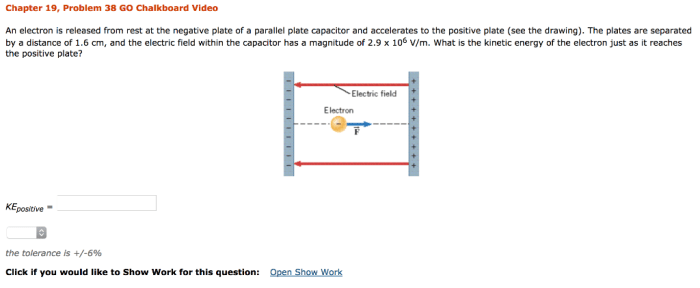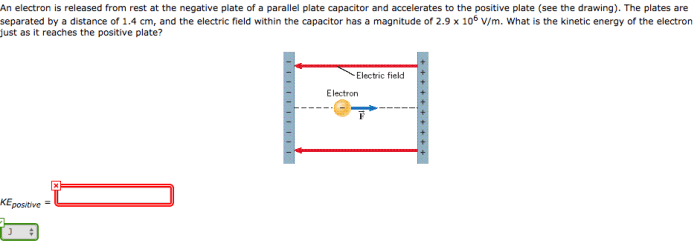An electron is released from rest at the negative plate, setting the stage for a captivating exploration of the interplay between electric fields and charged particles. This analysis delves into the electron’s motion, acceleration, and energy changes as it embarks on its journey away from the negative plate, providing insights into the fundamental principles governing charged particle dynamics.
The electric field exerts a force on the electron, causing it to accelerate and gain velocity. The electron’s trajectory is influenced by the electric field strength and its initial velocity. As the electron moves, its kinetic energy increases, reflecting the work done by the electric field.
An Electron is Released from Rest at the Negative Plate

Initial Conditions and Assumptions
An electron is released from rest at the negative plate of a parallel-plate capacitor. The plates are separated by a distance d, and the potential difference between the plates is V.
We assume that the electric field is uniform between the plates and that the electron’s motion is confined to one dimension.
Electric Field and Force
The electric field between the plates is given by:
The electric force acting on the electron is given by:
where e is the charge of an electron.
Electron’s Acceleration
The acceleration of the electron is given by:
where m is the mass of an electron.
The acceleration is constant, so the electron’s velocity increases linearly with time.
Electron’s Trajectory
The electron’s trajectory is a parabola. The electron moves in a straight line until it reaches the positive plate, at which point it is reflected back towards the negative plate.
The electron’s trajectory is determined by its initial velocity and the electric field strength.
Energy Considerations
The electron’s kinetic energy increases as it moves away from the negative plate. The electron’s kinetic energy is given by:
where v is the electron’s velocity.
The electron’s kinetic energy is equal to the work done by the electric field on the electron.
Limitations and Extensions, An electron is released from rest at the negative plate
The analysis presented here neglects the effects of gravity and other forces. It also assumes that the electric field is uniform between the plates.
Possible extensions to the analysis include considering a non-uniform electric field or an electron with a non-zero initial velocity.
Helpful Answers
What is the initial velocity of the electron?
Zero, as the electron is released from rest.
How does the electric field strength affect the electron’s motion?
A stronger electric field results in greater acceleration and velocity for the electron.
What is the significance of kinetic energy in this analysis?
Kinetic energy represents the energy gained by the electron due to the work done by the electric field.

